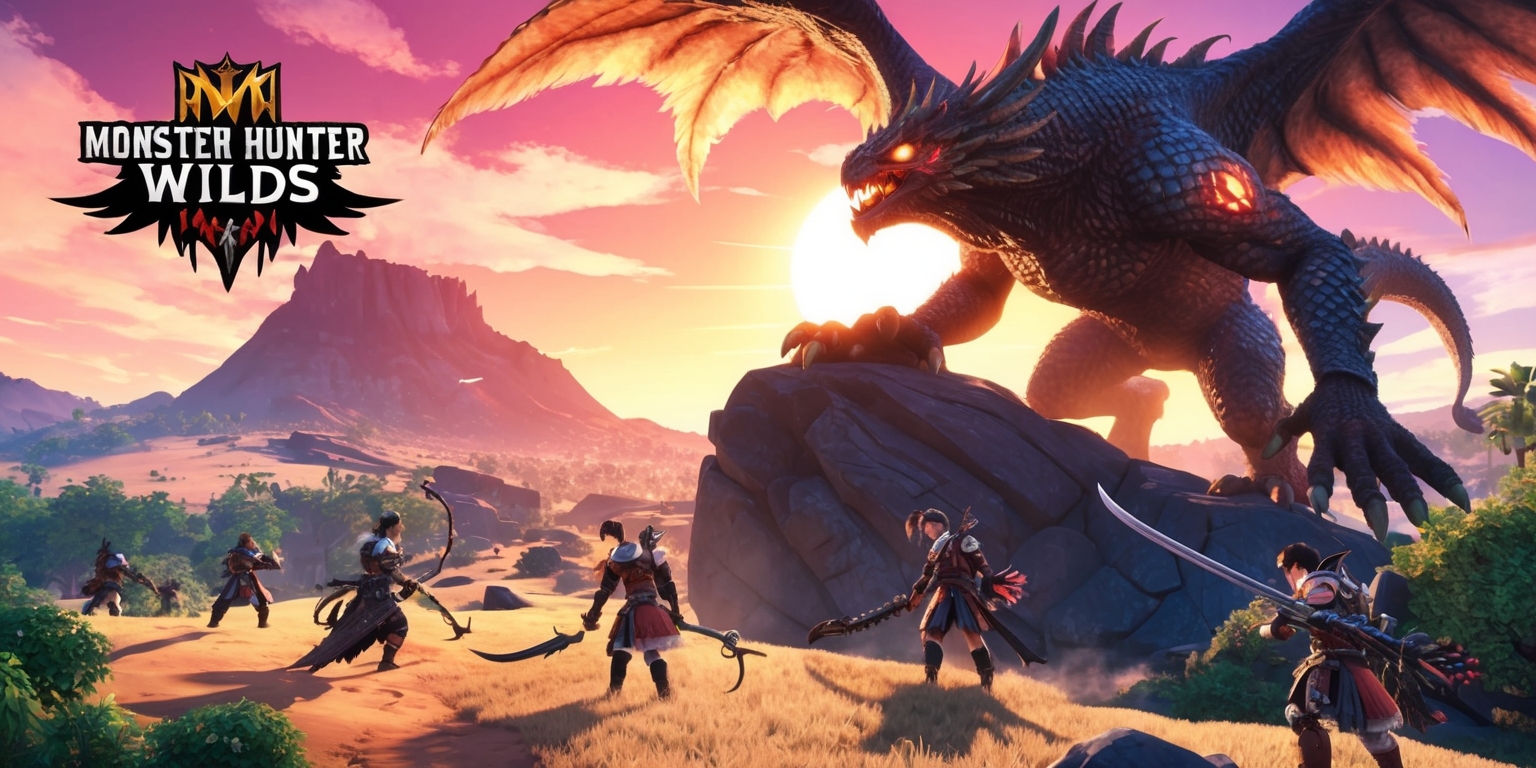Taming the Winds: Redefining Avian Control in Monster Hunter Wilds
Jul-16-2025

The world of Monster Hunter Wilds presents a unique blend of adventure and challenge, where every detail of gameplay can make the journey either frustrating or deeply satisfying. One standout example is the control scheme for your trusty avian mount, a creature that carries not only your secondary weapon and precious loot but also your hopes for a smooth expedition. Despite its charming comparison to more well-known mounts, players quickly discovered that this particular mount’s movement controls can be a source of irritation. With a few tweaks in the in-game options, however, what once was a perplexing flight experience transforms into something far more manageable, offering an engaging interplay between intuitive input and reliable performance. This piece aims to guide you through adjustments that ensure a more seamless traversal of the expansive digital wilds.
Mastering the Bird Mount Assistance
In the vast landscapes of Monster Hunter Wilds, your avian partner plays a critical role in exploration and combat support. This mount, reminiscent of iconic mounts from fantasy lore, is more than merely a vehicle for travel—it holds vital importance as well tool for carrying loot and even extra weapons. Its design, though innovative, brings a unique set of challenges in terms of control. The default automated movement system often results in unintentional motions that can disrupt your strategy when collecting resources or engaging with the environment. By venturing into the options and reassessing control settings, players have discovered methods to harness greater precision. Adjusting the control mode allows you to command this mount as effectively as you would your character, paving the way for improved gameplay and a more harmonious partnership between player and creature.
Refining Movement in the Wilderness
Among the most formidable obstacles encountered by hunters in Monster Hunter Wilds is the auto-move function that governs the avian mount. By default, the mount initiates movement in response to simple inputs like the up button or a quick tap on the keyboard. This convenience, however, turns into a disadvantage when precise navigation is necessary for tasks such as resource gathering. The automatic mode, designed to optimize routes, can sometimes ignore the subtlety required when maneuvering around delicate or scattered items on the ground. Fortunately, the game’s flexible control options offer room for improvement. Transitioning from an automatic system to one that mirrors the movement commands of your character leads to a more efficient in-game experience. This adjustment achieves a more refined equilibrium between the… bird’s innate momentum and your desire for precise positioning during intense moments of exploration.
Navigational Mechanisms and Their Impact
Delving deeper into the mechanics of the mount, it becomes apparent that the navigation system was engineered to follow a predetermined path determined by the game's algorithms. This pre-set route It may prove advantageous by lessening the mental burden on new players by offloading the complexity of pathfinding. Yet, for seasoned hunters looking for a more strategic approach, this continuous forward motion presents a significant drawback. The mount’s inability to decelerate or pause at critical moments can lead to inefficient movements, especially in environments dotted with collectibles like herbs and minerals. The workaround involves a subtle but effective adjustment—in shifting the control scheme from an automatic to a manual setup that requires constant input for movement. By doing so, players can better align the creature’s actions with their specific needs, ensuring smoother navigation through both familiar territories and uncharted regions.
Transforming Automatic to Manual Commands

Central to optimizing your in-game experience is the change from an automatic movement mode to one that demands manual input. In Monster Hunter Wilds, this shift is not only a workaround but a reimagining of how command inputs translate into on-screen actions. The default setting works well for rapid movement, but it can force the mount to continue moving regardless of your active commands—a limitation for those seeking precision. Adjusting the settings through the options menu allows for a configuration where movement occurs only when a specific button or key is pressed. This manual control mirrors the intuitive actions you perform with your character, fostering a sense of direct involvement with every maneuver. As a result, whether you are avoiding obstacles, positioning for combat, or carefully scanning for hidden items, the new setup delivers both responsiveness and reliability essential for an immersive hunting experience.
Customization and In-game Controls Setup
The journey toward a more refined control experience begins with a deep dive into the in-game options menu, a treasure trove for customization enthusiasts. Within this menu, the controls page offers an array of settings designed to tailor your gameplay to individual preferences. The spotlight falls on the bird mount’s settings; here, players can switch between different control modes. The default configuration, labeled as Type 1, inherently results in persistent movement—a behavior that many find counterproductive. By selecting the alternative, Type 2, the mount's controls become more attuned to deliberate player inputs. This manual configuration ensures that movement only occurs when a specific command is given via keyboard keys or the left thumbstick. The setup process is straightforward yet impactful, offering immediate improvements in the gameplay experience as the creature now mirrors the nuanced actions typically reserved for the player character.
Challenges in Controlling the Avian Companion
Despite the headway made in customizing control schemes, the sheer complexity of managing a living creature within a virtual realm cannot be underestimated. The bird mount, while charming in its design, represents a fine balance between fantasy allure and game mechanics. Its inherent ability to navigate quickly across broad distances is both a blessing and a curse. In moments when precision is demanded—such as while looting or navigating cluttered environments—the persistent forward momentum can quickly prove to be an impediment. Players must often contend with scenarios where split-second decisions hinge on the ability to halt movement effectively. This ongoing challenge has spurred developers and community enthusiasts alike to refine control toggles and tweak the input responsiveness, ensuring that the mount is not only an accessory but a fully integrated element of your adventure that does not disrupt the flow of gameplay.
Tactical Considerations and Game Strategies
Beyond the realm of simple control adjustments, the nuances of using the avian mount in Monster Hunter Wilds call for a tactical mindset. This mount is not merely a means of transport; it becomes a pivotal asset in your overall strategy, especially when venturing into territories fraught with unforeseen encounters or intricate terrain. Hungry for more efficient exploration and vigilant in resource management, many players opt to integrate the manual control settings into their broader in-game strategies. Relying on the ability to pause or adjust movement on demand can prove essential when navigating traps, ambushes, or even while coordinating with teammates during cooperative quests. The tangible benefits of this refined control are evident in the smoother execution of strategies designed to overcome environmental challenges—each decision supported by the newfound responsiveness of your creature companion.
Interface Upgrades and Player Adaptation
The evolution of control mechanisms in Monster Hunter Wilds exemplifies a broader trend seen across the gaming industry—continuous interface upgrades and the adaptation process by players. The transition from a default automatic system to a more manual approach represents a noteworthy shift, one that requires both a mental and a practical adjustment. Early in the game, the streamlined button prompts are aimed at easing new players into the world, but as encounters become more complex, the versatility of manual controls takes precedence. Through clear and responsive interfaces, players are now empowered to fine-tune their settings, gradually embracing a system that demands more active participation in navigation and combat. This adaptation It not only elevates the gaming experience but also embodies a broader appreciation for user customization and the incremental innovation that defines modern interactive entertainment.
Interactive Game Environment and Feedback
Monster Hunter Wilds continues to captivate players with an interactive environment that pushes the boundaries of immersive Interactive mechanics. One of the most captivating facets of the experience is navigating this realm is the immediate feedback supplied by the game’s control dynamics. When using the modified settings for the avian mount, each keystroke or thumbstick movement results in quick, precise adjustments that are seamlessly integrated into the game’s physics and environmental interactions. Such responsiveness enhances the overall realism and fluidity of your explorations, allowing sudden changes in the terrain to be met with equally swift reactions from your trusty mount. This tight feedback loop is critical to maintaining balance across fast-paced chases and methodical luring of elusive resources, reinforcing the theme that effective customization directly contributes to a heightened state of in-game immersion.
Seamless Exploration with Responsive Features
The practical benefits of refined control settings extend to the core of Monster Hunter Wilds' exploratory gameplay. With the enhanced manual configuration now in place, your avian ally behaves as a true extension of your will rather than an independent agent. This increased responsiveness is especially critical when navigating delicate or hazardous landscapes where every moment counts. The improved control mechanism allows for adjustments on the fly, reducing the risk of unintended movements that might otherwise lead to lost opportunities or unwanted detours. Whether you are trekking across expansive open fields or maneuvering near intricate environmental structures, the ability to dictate each movement precisely transforms exploration from a routine task into a carefully orchestrated dance. The shift from passive auto-movement to dynamic player-driven input is a serving as evidence that even the smallest tweaks can drive substantial results improvements in the overall gaming experience.







